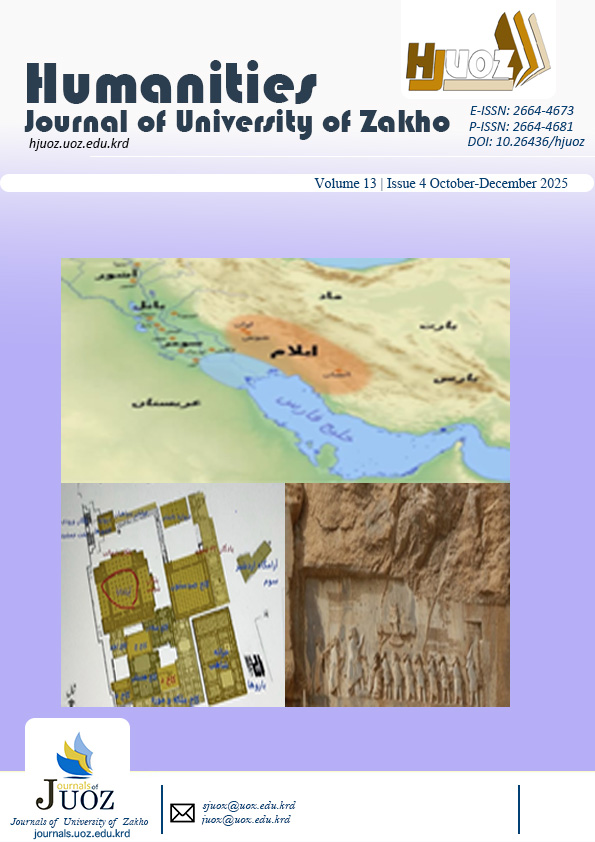BEYOND CONSOLIDATING POWER: THE LOGIC AND ADAPTABILITY OF POLITICAL PURGES IN STALIN’S SOVIET UNION, SADDAM’S IRAQ, AND THE ASSAD’S SYRIA
DOI:
https://doi.org/10.26436/hjuoz.2025.13.4.1658Keywords:
Political Purges,, Authoritarianism, Stalinism, Ba’athist Ideology, Sectarian Violence,, Institutionalized Fear, Kurd, USSR, Syria, IraqAbstract
This study analyzes the role of purges as systemic mechanisms of governance within Stalin’s Soviet Union, Saddam Hussein’s Iraq, and Assad’s Syria. While commonly perceived as instruments for power consolidation, this paper argues that purges extend beyond tactical purposes to function as institutionalized practices. These mechanisms enforced elite loyalty, restructured power dynamics, and suppressed dissent, serving as adaptive strategies for authoritarian resilience. The analysis identifies shared patterns, such as a dual-phase structure targeting external threats before focusing on internal rivals, while also exploring ideological, structural, and personalist dimensions. Despite ideological differences—Marxist-Leninist revolution in Stalin’s USSR, Ba’athist Arab nationalism in Iraq, and sectarian authoritarianism in Syria—the study reveals a universal adaptability of purges to the vulnerabilities of authoritarian regimes. Using Wintrobe’s (1998) concept of the “fear equilibrium” and Tilly’s (2003) theory of institutionalized violence, this comparative framework advances the understanding of authoritarian resilience and the strategic role of violence in state control.
.
Downloads
References
Aburish, S. K. (2000). Saddam Hussein: The Politics of Revenge. Bloomsbury Publishing.
Amnesty International. Syria: Torture, Despair and Dehumanisation in Tadmur Military Prison. London: Amnesty International, 2001. https://www.refworld.org/reference/countryrep/amnesty/2001/en/40320A
Applebaum, A. (2017). Red Famine: Stalin's War on Ukraine. Doubleday.
Bueno de Mesquita, B., Smith, A., Siverson, R. M., & Morrow, J. D. (2003). The logic of political survival. Cambridge, MA: MIT Press.
Chandler, D. P. (1999). Voices from S-21: Terror and history in Pol Pot's secret prison. University of California Press.
Conquest, R. (1986). The Harvest of Sorrow: Soviet Collectivization and the Terror-Famine. Oxford University Press.
Conquest, R. (2008). The Great Terror: A Reassessment. Oxford University Press
Coughlin, C. (2005). Saddam: His rise and fall. HarperCollins.
Dagher, S. (2019). Assad or We Burn the Country: How One Family's Lust for Power Destroyed Syria. Little, Brown
Daher, J. (2020). Hezbollah: Mobilization and power. London: Pluto Press.
Daher, J. (2019). Syria After the Uprisings: The Political Economy of State Resilience. Pluto Press.
Fitzpatrick, S. (1999). Everyday Stalinism: Ordinary Life in Extraordinary Times: Soviet Russia in the 1930s. Oxford University Press.
France 24 (2024, December 8). Why the Assad regime collapsed in Syria – and why so fast. France 24. Retrieved from https://www.france24.com/en/middle-east/20241208-why-the-assad-regime-collapsed-in-syria-and-why-so-fast
Gelvin, J. L. (2011). The modern Middle East: A history (3rd ed.). Oxford University Press.
Getty, J. A. (1987). Origins of the Great Purges: The Soviet Communist Party Reconsidered, 1933–1938. Cambridge University Press
Getty, J. A., & Naumov, O. V. (1999). The Road to Terror: Stalin and the Self-Destruction of the Bolsheviks, 1932–1939. Yale University Press.
Goldring, E., & Matthews, A. S. (2023). To purge or not to purge? An individual-level quantitative analysis of elite purges in dictatorships. British Journal of Political Science, 53(1), 44–63. https://doi.org/10.1017/S0007123421000569
Hiltermann, J. R. (2007). A poisonous affair: America, Iraq, and the gassing of Halabja. Cambridge University Press.
Human Rights Watch. (1993). Genocide in Iraq: The Anfal Campaign Against the Kurds. Human Rights Watch. Retrieved from https://www.hrw.org/reports/1993/iraqanfal/ANFALINT.htm
Jansen, M., & Petrov, N. (2002). Stalin's Loyal Executioner: People's Commissar Nikolai Yezhov, 1895–1940. Hoover Institution Press.
Karsh, E., & Rautsi, I. (1991). Saddam Hussein: A Political Biography. Grove Press.
Khlevniuk, O. (2015). Stalin: New Biography of a Dictator. Yale University Press.
Kirmanj S and Rafaat A (2021) The Kurdish genocide in Iraq: the security-Anfal and the identity-Anfal. National Identities 23(2): 163–183.
Kirmanj, S. (2013). Identity and Nation in Iraq: Survival in a hostile environment. Lynne Rienner Publishers.
Lesch, D. W. (2012). Syria: The fall of the House of Assad. New Haven: Yale University Press.
Levitsky, S., & Ziblatt, D. (2018). How democracies die. New York, NY: Crown Publishing Group.
MacFarquhar, R., & Schoenhals, M. (2008). Mao's last revolution. Cambridge, MA: Belknap Press of Harvard University Press.
Makiya, K. (1998). Republic of Fear: The Politics of Modern Iraq. University of California Press.
Martin, T. (2001). The Affirmative Action Empire: Nations and Nationalism in the Soviet Union, 1923–1939. Cornell University Press.
Montagnes, B. P., & Wolton, S. (2019). "Mass Purges: Top-Down Accountability in Autocracy." American Political Science Review, 113(4), 1045–1059 https://doi.org/10.1017/S0003055419000456
Penguin History. “When Saddam Hussein Held a Public Purge.” YouTube video, September 7, 2024. Accessed October 9, 2025. https://www.youtube.com/watch?v=MohJLPgutKQ
Phillips, C. (2015). "Sectarianism and authoritarianism in the Middle East." International Affairs, 91(3), 475–497.
Power, S. (2002). A problem from hell: America and the age of genocide. Basic Books.Remmer, K. L. (1989). Neopatrimonialism: The politics of military rule in Chile, 1973–1987. Comparative Politics, 21(2), 149–170. https://doi.org/10.2307/422069
Reuters (2024, December 12). Demoralised and abandoned by allies: Why Assad's army failed to fight in Syria. Reuters. Retrieved from https://www.reuters.com/world/middle-east/demoralised-abandoned-by-allies-why-assads-army-failed-fight-syria-2024-12-12/
Reuters (2024, December 13). Assad's final hours in Syria: Deception, despair and flight. Reuters. Retrieved from https://www.reuters.com/world/middle-east/assads-final-hours-syria-deception-despair-flight-2024-12-13/
Sassoon, J. (2012). Saddam Hussein’s Ba’ath Party: Inside an Authoritarian Regime. Cambridge University Press.
Seale, P. (1989). Asad: The Struggle for the Middle East. University of California Press.
The New Yorker (2024). How Assad's regime crumbled. The New Yorker. Retrieved from https://www.newyorker.com/news/q-and-a/how-bashar-al-assads-regime-crumbled
Tilly, C. (2003). The Politics of Collective Violence. Cambridge University Press.
United States Congress. Congressional Record, vol. 144, no. 15 (Senate), February 25, 1998. “Kamel was killed on his return to Iraq in 1996.” Congressional Record — Senate, S953–S954. https://www.govinfo.gov/content/pkg/CREC-1998-02-25/pdf/CREC-1998-02-25-senate.pdf
Van Dam, N. (2011). The Struggle for Power in Syria: Politics and Society under Asad and the Ba'th Party. I.B. Tauris.
Wintrobe, R. (1998). The Political Economy of Dictatorship. Cambridge University Press.
Published
How to Cite
Issue
Section
License
Copyright (c) 2025 Soran Tarkhani

This work is licensed under a Creative Commons Attribution-NonCommercial-ShareAlike 4.0 International License.
Authors who publish with this journal agree to the following terms:
- Authors retain copyright and grant the journal right of first publication with the work simultaneously licensed under a Creative Commons Attribution License [CC BY-NC-SA 4.0] that allows others to share the work with an acknowledgment of the work's authorship and initial publication in this journal.
- Authors are able to enter into separate, additional contractual arrangements for the non-exclusive distribution of the journal's published version of the work, with an acknowledgment of its initial publication in this journal.
- Authors are permitted and encouraged to post their work online.

















